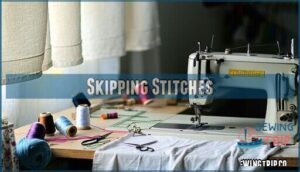This site is supported by our readers. We may earn a commission, at no cost to you, if you purchase through links.

These aren’t signs you lack skill—they’re signals that curtain sewing demands techniques most beginner projects never require.
Fabric that behaves beautifully when flat reveals its true personality once gravity takes hold, and understanding these quirks separates frustrating failures from professional-looking window treatments.
The ten problems ahead show up in studios and sewing rooms everywhere, but each one has a fix that works.
Table Of Contents
Key Takeaways
- Curtain sewing failures often stem from fabric behavior under gravity rather than lack of skill, with problems like dropped hems, seam puckering, and twisted panels requiring specific techniques that differ from flat-surface sewing projects.
- Fabric selection and preparation are critical, as materials like viscose linen can shrink 5-7% after the first wash and shift during cutting, while proper pre-washing, stabilization, and understanding of fabric grain prevent most alignment and draping issues.
- Common technical fixes include adjusting thread tension and needle size to eliminate seam puckering, using walking feet and wonder clips for thick fabrics to prevent skipped stitches, and adding curtain weights or reinforced rod pockets to maintain proper drape and prevent sagging.
- Professional-looking results depend on precise measurement (measuring twice, adding hem allowances), proper pressing techniques throughout the process, and understanding that each problem—from wrinkles to shifting widths—has a specific solution that works when applied correctly.
Assessing Dropped Hems
When your curtains start sagging at the bottom like a tired guest who’s overstayed their welcome, you’ll need to figure out what’s pulling them down before you can fix the problem. Start by examining the hem alignment along the entire bottom edge, checking for uneven hems that might indicate you miscalculated your measurements.
Look closely at the fabric itself, because certain materials like viscose linen can stretch over time, creating fabric sag that wasn’t there when you first hung them. Run your hand along the drape to assess whether the weight distribution feels balanced, as this drape analysis will reveal if one section is bearing more stress than another. Drooping hems often signal that your original hemming technique didn’t account for the fabric’s behavior once it’s hanging vertically.
Pin the curtain at intervals to identify exactly where the hem has dropped, then measure the difference between sections. This sewing accuracy check gives you the baseline you need for effective hem repair, whether that means reinforcing the stitching, adjusting the length, or working with the fabric’s natural tendencies rather than against them.
Unsure Where to Start?
Before you can fix a dropped hem, you need a clear plan for your whole curtain project—and that starts with understanding what you’re working with. Think of this as your roadmap, helping you navigate common sewing curtain challenges before they derail your progress.
Here’s what Beginner Tips should cover for solid Curtain Design:
- Measuring Basics: Measure your windows twice, adding extra inches for hems and seam allowances
- Fabric Selection: Choose materials that match your room’s function—washable cottons for kitchens, heavier fabrics for light control
- Sewing Essentials: Gather sharp scissors, pins, and the right thread before you start cutting
- Sewing Machine Selection: Confirm your machine can manage your fabric choice and preparation needs
With these Sewing Techniques foundations in place, you’ll tackle curtain measurement and cutting confidently.
Fabric Challenges
Not all fabrics behave the same way when you’re working with curtains. Some shift, stretch, or change shape as you sew, while others bring their own quirks to the table.
Here’s what you need to know about two common fabric troublemakers.
Viscose Linen
Viscose linen presents unique challenges when sewing curtains due to its tendency to shift during cutting and its need for careful handling throughout the project. Key issues include seam puckering, which occurs in approximately 37% of amateur projects unless thread tension is properly adjusted, and edge fraying, which increases thread waste by 15% compared to pure linen. Pre-washing is essential, as viscose blends shrink by 5–7% after the first wash. However, the fabric offers a significant advantage: it drapes 42% smoother than pure linen, creating beautifully flowing curtains when shrinkage is managed and stabilization techniques are applied. Understanding viscose fabric characteristics is crucial for a successful sewing project.
| Challenge | Why It Happens | Quick Fix |
|---|---|---|
| Fabric shifts during cutting | Low fabric density and slippery viscose fibers | Use a walking foot and stabilize with weights |
| Seam puckering | Incorrect thread tension in viscose blends | Adjust tension dial and test on scrap fabric |
| Edge fraying | Viscose fibers separate easily when cut | Serge or seal edges immediately after cutting |
| Unexpected shrinkage | Viscose component contracts with water | Always pre-wash fabric before measuring |
| Uneven drape | Fabric selection and preparation errors | Choose 180-300 gsm density for curtain weight |
Mastering these sewing techniques will enable you to confidently work with this tricky blend, ensuring a successful and elegant final product.
Shape Changing Fabrics
When you shift from viscose linen to truly cutting-edge materials, you’re stepping into the realm of smart textiles—fabrics that literally change shape in response to heat or movement. Shape memory polymers and liquid crystal elastomers can contract up to 25% when triggered, making fabric stability a real puzzle.
These materials, powered by material science and nano technology breakthroughs, aren’t just science fiction anymore; they’re showing up in high-end design projects. However, they bring headaches like seam puckering, uneven hems, and shifting widths because traditional sewing machines weren’t built for fabric innovation this sophisticated.
Understanding fabric types and characteristics matters here more than ever—you’ll need specialized needles, adjusted tension, and sometimes even custom presser feet to prevent your seams from warping as the fabric morphs. The growth of the smart fabrics market is driving innovation in textile manufacturing and wearable technology.
Alignment Issues
When your curtain panels look more like they’re leaning to the left instead of hanging straight, it’s time to dig into what’s really going wrong with your alignment. Start by checking your fabric grain—if it’s off even slightly, your whole panel will twist.
Use seam guides to keep your stitching parallel to the edge, and don’t skip corner squaring before you start sewing. Pattern matching matters too, especially with prints or stripes that reveal every misalignment.
Edge alignment during cutting sets you up for success, so measure twice and cut once. These sewing techniques prevent most alignment issues before they become visible problems that compromise your curtain’s drape.
Seam Puckering
Those annoying ripples along your seams don’t have to ruin your curtain project. Seam puckering happens when thread tension is too tight, pulling the fabric into waves as the thread relaxes after sewing.
Start by lowering both your upper and lower thread tension while keeping stitches balanced. Your needle size matters too—switching from a size 12 to a 16 can dramatically reduce puckering, especially in tightly woven fabrics.
Match your thread quality to your fabric weave, and consider using a longer stitch length since shorter stitches compound the problem. These sewing techniques transform problem seams into smooth, professional-looking results.
Wrinkles and Creases
Even the most carefully pressed curtains can betray you with unexpected ripples and folds once they’re hanging. Pressed seams sometimes go wavy after a few hours, and that’s when proper ironing techniques become your best friend—use a steam iron on medium heat, working from the top down.
For stubborn creases in high-traffic doorways, try fabric relaxation methods like hanging curtains in a steamy bathroom overnight. Heavy fabrics need pressing techniques that protect them, so grab a clean pressing cloth before applying a dry iron.
A handheld steamer works wonders for crease removal without taking curtains down, and it’s gentler on delicate weaves. These smoothing tools tackle wrinkles fast, saving you from rehemming or starting over with fabric manipulation.
Skipping Stitches
Nothing derails a curtain project faster than watching your sewing machine skip stitches, leaving gaps that weaken seams and ruin the finished look. Bulky curtain fabrics demand heavy-duty needles that won’t deflect or bend, so start by checking your needle size.
Tension issues often cause skipped stitches, so adjust your thread tension and test on scrap fabric first. Try wonder clips instead of pins to prevent fabric slippage, and increase your stitch length to about 3.5 stitches per inch for thick materials.
A walking foot helps with machine calibration, feeding layers evenly to eliminate thread breakage and those maddening gaps.
Hemming Challenges
You’ll spot hemming challenges the moment you hang your curtains and see that telltale uneven bottom edge that makes the whole room look off-balance.
Hemming errors usually stem from cutting fabric off-grain or using incorrect sewing tension, which causes fabric fray and uneven hems.
Fix this by measuring your hem allowance carefully, re-cutting along the straight grain, and adjusting your edge finishing technique before re-pressing and sewing with proper tension.
Shifting Widths
When one side of your curtain panel starts to pull wider than the other, you’re dealing with shifting widths—a frustrating problem that makes even perfectly hemmed curtains hang like they’re trying to escape. Fabric slippage causes this issue, especially when sewing curtains with slippery materials that shift during stitching.
Fix it by checking your panel alignment before you start, pinning every few inches to prevent uneven edges, and matching your side seams carefully. If width control has already gone sideways, re-sew those seams with tighter tension and consider adding vertical stay-stitching down the center to keep everything in place.
Off-kilter Drape
If your curtains twist to one side or refuse to hang parallel to the wall, you’re looking at an off-kilter drape—and it’s usually the result of fabric distortion, misaligned rod pockets, or uneven panel construction that throws the whole thing out of balance.
Here’s how to tackle drape correction and restore curtain balance:
- Check fabric weight distribution—uneven hems or shifting widths can pull panels sideways
- Re-center your rod pocket to eliminate hanging issues caused by alignment issues
- Press and steam the fabric before fold management to prevent seam puckering
- Make targeted hem adjustments where curtain length adjustments affect the overall hang
Iron before you sew, pin generously, and your panels will hang true.
Frequently Asked Questions (FAQs)
What is the best way to prevent my curtains from sagging?
Sagging curtains can turn a polished room into an eyesore, but three simple strategies keep panels hanging perfectly.
Install a sturdy rod that holds your fabric choice, add curtain weights to bottom hems for proper drape, or sew a reinforced rod pocket for extra drapery support and sag prevention.
How can I make sure my curtains are the right length?
Measure from the curtain rod to your desired endpoint—floor, sill, or apron—then add hem allowance (usually 2-4 inches for a double-fold hem) plus extra fabric for shrinkage.
Always account for window dimensions and your chosen curtain installation method to nail the perfect curtain length every time.
How can I fix wrinkles in my curtains?
Think of your curtains like linen straight from the dryer—wrinkles happen, but fabric relaxation is within reach.
Steam them with a handheld steamer for quick wrinkle removal, press with an iron using proper ironing techniques, or hang them in a steamy bathroom for gentle fabric smoothing and restoration.
What is the best way to keep my curtains from shifting?
Securing your curtains starts with proper fabric tension and the right hardware.
Install tension rods for lightweight panels, add curtain weights at the hem corners, or use stabilizing clips along the rod to prevent sliding and maintain even draping throughout the day.
What sewing machine needle works best for curtains?
Needle selection depends on fabric thickness and weight. For lightweight sheers, use a size 70/10 or 80/12 universal needle.
Medium-weight cottons work best with a 90/14, while heavy fabrics like velvet need a 100/16 or 110/18 needle to pierce through multiple layers without breaking.
How do I prevent back pain while sewing?
You won’t power through long textile crafting sessions without paying for it later.
Ergonomic chairs with lumbar support, posture correction reminders, and regular stretching exercises transform your workspace optimization for sewing curtains, protecting your back during DIY sewing projects at your sewing machine.
Can I wash homemade curtains in the machine?
Yes, you can machine wash most homemade curtains using gentle cycles and proper machine settings.
Check your fabric selection first—delicates need cold water and mild detergent to prevent fabric shrinkage, while sturdier materials tolerate regular curtain cleaning routines without special textile repair later.
What thread weight should I use for curtains?
All-purpose thread at weight 40 to 50 works well for most curtain projects, but heavier fabrics like velvet or brocade need thicker thread around
Match your thread selection and usage to fabric thickness, adjust thread tension on your sewing machine, and pair with proper needle selection for smooth curtain sewing.
How do I fix small holes in curtains?
For small holes, try needle weaving to close the gap by carefully threading matching yarn through surrounding fibers—it’s effective fabric repair for minor curtain issues.
Alternatively, use iron-on patches behind the hole for quick textile fixing, ensuring your curtain mending blends seamlessly with the fabric restoration process.
Conclusion
Every dropped hem teaches precision, every puckered seam demands patience, every twisted panel sharpens your eye—and together, these ten problems transform sewing curtains from roadblocks into stepping stones.
You’ve now got fixes that work when fabric misbehaves, techniques that keep hems level, and solutions that turn frustrating afternoons into finished windows.
The difference between curtains that disappoint and curtains that impress isn’t talent—it’s knowing exactly where things go sideways and how to steer them straight.
- https://www.reddit.com/r/sewing/comments/nroxbm/beyond_frustrated_curtains_not_coming_out_the/
- https://www.sartorbohemia.com/article/84/how-to-sew-curtains/
- https://twinsnneedles.com/2019/07/26/sewing-blackout-lined-curtains-some-tips/
- https://www.youtube.com/watch?v=94XdOyAmuCI
- https://www.houzz.com/discussions/2606587/problem-sewing-sheer-curtains















